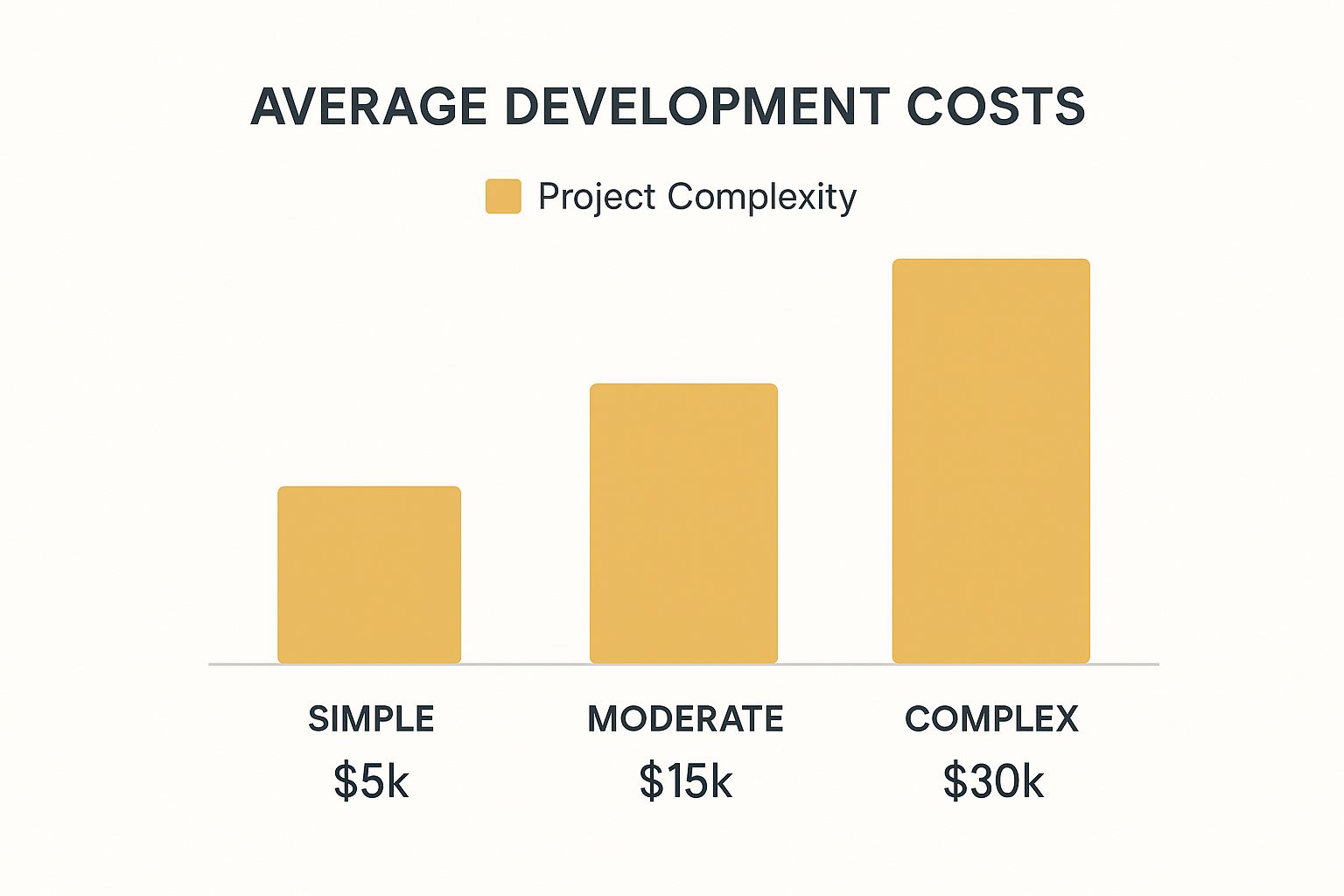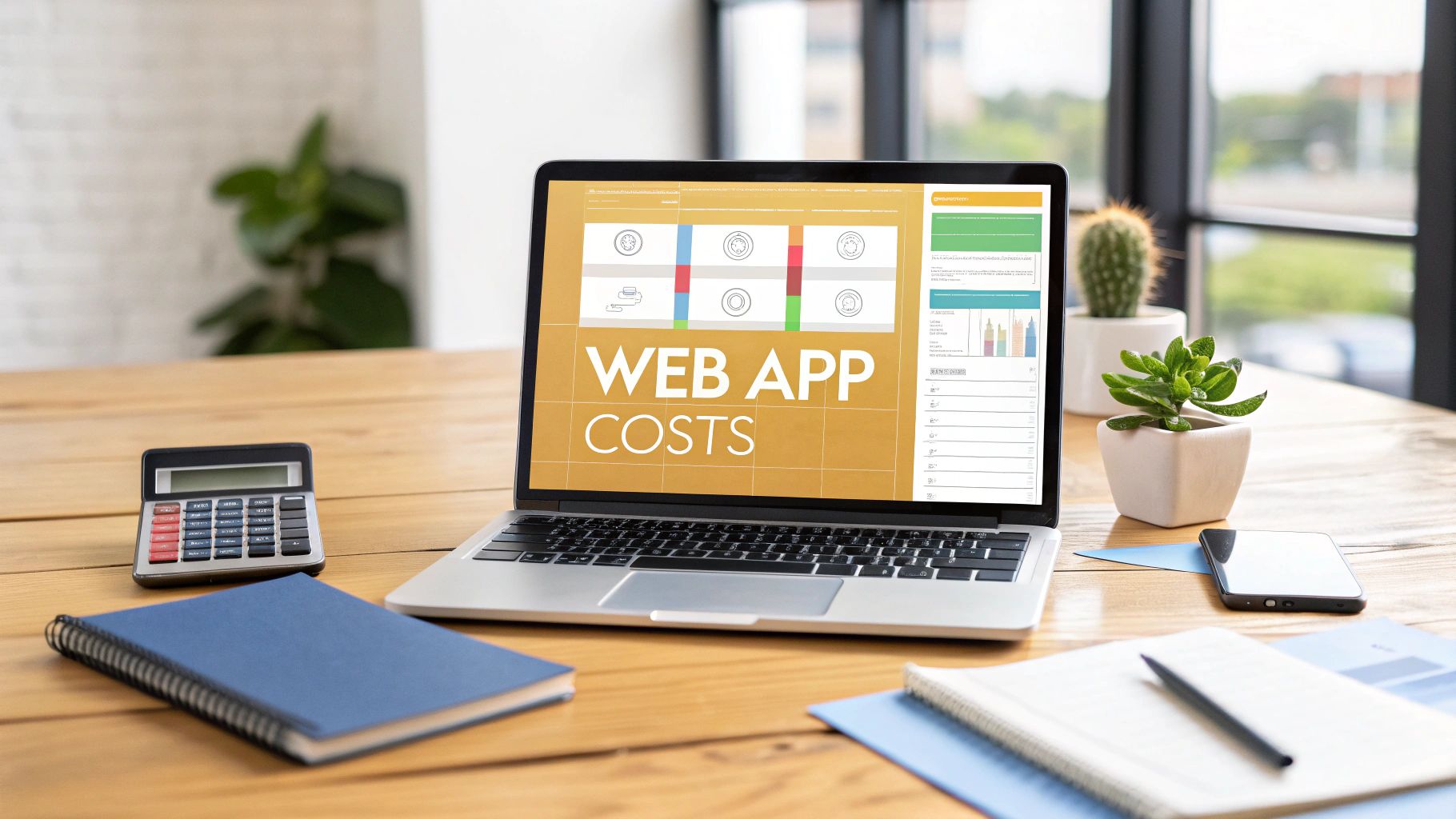Let's be honest—the first question everyone asks about building a new web app is, "how much is this going to cost?" While the true answer is always "it depends," we can definitely map out some clear benchmarks to give you a realistic starting point.
A web app can run you anywhere from $5,000 for something simple to well over $250,000 for a complex, feature-packed platform. The final number really boils down to the features you need, the sleekness of the design, and the team you hire to build it. Think of it as a spectrum: on one end, you have a basic online brochure; on the other, a massive enterprise system. Your idea will land somewhere in between.
Breaking Down Web App Development Costs
Understanding the different cost tiers helps you line up your expectations with your budget. It also means you can have much more productive conversations with potential development partners right from the get-go.
I like to compare it to buying a car. You could get a reliable sedan for your daily commute, a versatile SUV with more space and features, or a high-performance sports car built for raw power. Each one serves a different purpose and has a price tag to match. Web applications are exactly the same—they're tools built to solve specific business problems, and what they cost reflects what they can do.
Tiers of Web Application Costs
To make sense of the huge price range, it helps to break projects down by complexity.
Simple apps with just the essential features, like a basic online presence for a small business, usually fall in the $5,000 to $15,000 range. Moving up a notch, medium-complexity apps that offer a richer user experience—maybe a Single-Page Application with a few integrations—are generally going to cost between $15,000 and $60,000. If you want to get deeper into the financial side of things, check out our guide on software development cost estimation.
The most complex web applications—the ones with advanced security, custom admin panels, payment processing, and the muscle to handle tons of users—start at around $60,000 and can easily climb past $250,000. We're talking about enterprise-level SaaS platforms and large-scale operations that need a seriously robust and scalable foundation.
To help you get a clearer picture of where your project might fit, here’s a quick guide to the different cost tiers.
Quick Guide to Web Application Cost Tiers
This table breaks down the typical costs you can expect based on how complex your web application needs to be.
| Complexity Level | Typical Features | Estimated Cost Range | Ideal For |
|---|---|---|---|
| Simple | Basic UI, contact forms, static pages, simple search | $5,000 - $15,000 | Startups, small businesses, MVPs |
| Medium | User accounts, API integrations, custom dashboards | $15,000 - $60,000 | Growing businesses, e-commerce stores |
| Complex | Advanced security, payment gateways, real-time data | $60,000 - $250,000+ | Enterprises, SaaS products, large platforms |
Think of these numbers as a solid foundation for your budget planning. As you start mapping out your features, you'll get a much better feel for where your project lands on this spectrum.
The Core Factors That Drive Your Budget

Knowing the general price tiers is a good start, but what actually moves the needle on those numbers? The web application development costs you’ll face are a direct result of the choices you make long before anyone writes a single line of code. Every decision adds another layer of work, which always translates to more development hours and a bigger final invoice.
I like to use a house-building analogy. A simple, one-story home with standard fixtures comes with a fairly predictable cost. But the moment you add a second floor, custom kitchen cabinets, and a fancy smart home system, everything changes. You need more materials, specialized labor, and more time on the job site. Your web app is exactly the same.
Let’s get into the four main ingredients that have the biggest impact on your budget. Getting a handle on these will help you have much smarter conversations with your development team and make better trade-offs as you go.
The Complexity of Your Features
The single biggest thing that drives up cost is the complexity of what you want your app to do. A feature is never just a button you see on the screen; it’s a whole system whirring away behind the scenes. More features and more complex logic mean more time for developers to design, build, and test.
Think about the difference between a basic blog and a real-time analytics dashboard. The blog just needs to show text and images, which is pretty straightforward. The dashboard, on the other hand, has to crunch huge amounts of data, run calculations on the fly, and update charts instantly. That requires a much more sophisticated setup and some serious programming chops.
Here are a few examples of features that will definitely inflate your costs:
- Real-time functionality: Things like live chat, instant notifications, or tools where multiple people can edit at once require a complex backend to keep everything in sync.
- Custom algorithms: If your app needs a unique recommendation engine or a specialized tool to process data, developers have to build that logic from the ground up.
- Third-party integrations: Connecting your app to other services like payment gateways (Stripe), CRMs (Salesforce), or social media platforms always adds development time.
The Role of UI UX Design
How your app looks and feels—the User Interface (UI) and User Experience (UX)—is another huge cost factor. Going with a generic, template-based design is the cheapest route, but it’s not going to make your app memorable.
A custom UI/UX design, however, is built specifically for your brand and your users. The process involves research, wireframing, prototyping, and user testing to create something that feels intuitive and just works. While a custom design costs more at the start, a bad user experience will cost you customers later. In fact, some studies show a well-designed UI can boost conversion rates by up to 200%.
Your app's design isn’t just about looking pretty; it’s about usability. Investing in a professional, custom design makes your app intuitive and enjoyable to use, which directly impacts whether users stick around.
Backend Architecture and Technology Stack
The "backend" is the engine under the hood of your application. It’s the server, the database, and all the logic that users never see but that powers every single thing they do. The decisions made here have a massive impact on your app's performance, how easily it can grow, and—you guessed it—the cost.
For instance, an app built to handle a few hundred users has a way simpler backend than one designed to support hundreds of thousands of people all at once. An app expecting heavy traffic needs a scalable architecture, probably using things like microservices and cloud infrastructure (AWS or Google Cloud), which adds a lot of complexity and cost.
The technology stack—the programming languages, frameworks, and tools used to build everything—also plays a part. Using a popular, well-supported stack is often more cost-effective than choosing a niche technology that requires finding specialized, and usually more expensive, developers. This is one of those key areas where a little foresight can really help you manage your web application development costs.
Choosing Your Development Team and Pricing Model
Deciding who builds your web app and how you pay them are two of the biggest calls you'll make. These choices don't just affect your budget—they shape your timeline, the quality of the final product, and honestly, your stress level for the next few months. The right partnership can feel like having a co-pilot on your journey, while the wrong one can feel like flying solo through a storm.
Let's break down your options for building a team and the pricing structures they typically use. Getting this right is critical for controlling your web application development costs and setting your project up for a smooth takeoff.
Comparing Development Team Models
You've basically got three main routes for getting your app built: hiring freelancers, partnering with an agency, or building an in-house team. Each path has its own trade-offs when it comes to cost, control, and how easily you can scale up or down.
- Freelancers: This is often the most budget-friendly option, especially for specific, well-defined tasks. A freelance developer can be perfect for a small, contained project or for adding a single feature. The downside? Juggling multiple freelancers can quickly turn into a full-time management job.
- Development Agency: An agency brings a whole, pre-built team to the table—project managers, designers, developers, and QA testers, all working in sync. You get a ton of expertise and streamlined processes, but it definitely comes at a higher price point than hiring a solo freelancer.
- In-house Team: Building your own team gives you the ultimate level of control and creates deep knowledge about your product right inside your company. However, it's easily the most expensive and time-consuming route, involving recruitment, salaries, benefits, and all the long-term overhead that comes with employees.
When you're weighing these options, don't forget to look at the global talent pool. Exploring strategies like hiring talent abroad to reduce costs can be a game-changer for your budget, giving you access to top-tier expertise at much more competitive rates.

Demystifying Pricing Models
Once you've figured out who is building your app, you need to agree on how they get paid. In the web development world, it almost always comes down to two models: Fixed Price or Time & Materials. The right choice really depends on how clear your project vision is from the start.
A Fixed Price model is like getting a binding quote from a contractor to build a house from a detailed blueprint. You agree on the exact scope of work for one set price. This works great for smaller projects where the requirements are crystal-clear, but watch out—any changes (what we call "scope creep") will mean a new contract and extra costs.
A Time & Materials (T&M) model is more like paying that same contractor by the hour for a renovation. You know you might find unexpected issues behind a wall or decide to change the layout as you go. You pay for the actual hours worked and the resources used. This approach gives you flexibility and is perfect for complex, long-term projects where the requirements are bound to evolve.
Key Takeaway: A Fixed Price model gives you budget certainty but almost zero flexibility. A Time & Materials model offers the flexibility to adapt and evolve, but it requires a lot more trust and active budget management on your part.
Comparing Pricing Models for Web Development
So, which model is the best fit for your project's scope and flexibility needs? This table breaks down the pros and cons to help you decide.
| Pricing Model | Best For | Pros | Cons |
|---|---|---|---|
| Fixed Price | Small, well-defined projects with crystal-clear requirements. | Predictable budget and deliverables, minimal management needed. | Totally inflexible, risk of rushed work, and making changes is expensive. |
| Time & Materials | Complex, long-term projects where the scope is likely to evolve. | High flexibility, often leads to a better product, supports agile development. | Less budget predictability upfront, requires a high degree of trust and communication. |
Choosing the right pricing model is about balancing your need for a predictable budget against your need for flexibility. There's no single "best" answer—it's all about what makes sense for your specific project.
The global market for web applications is absolutely booming, with projections expecting it to hit $10.149 billion by 2027. This insane growth shows just how much businesses are investing in digital tools. A huge chunk of that investment is in development costs, which can swing wildly based on your team's location and how complex your project is.
For example, a basic web app might start around $8,000 in Eastern Europe, while a feature-rich SaaS platform can easily soar past $50,000 in North America. Even with those numbers, businesses often see a 3x to 5x return on investment from their web apps, turning a major expense into a powerful strategic asset.
Real-World Examples of Web App Costs

Abstract numbers are one thing, but seeing how they play out in the real world makes everything click. To bring web application development costs to life, let's walk through three common project scenarios. Each one shows how adding more features and complexity directly bumps up the final price tag.
Think of these as project blueprints. By looking at a simple, mid-tier, and complex application, you can start to get a feel for where your own idea might land on the cost spectrum. We'll break down the core features, the team you’d need, and a realistic budget for each.
Scenario 1: Simple Portfolio and Lead Generation Site
Imagine a freelance photographer or a small consulting firm that needs a professional online presence. Their goal isn't to sell products directly but to showcase their work, build credibility, and capture leads. This is a classic example of a simple, informational web app.
The whole point is straightforward communication. It needs to look sharp and work flawlessly, but it doesn’t require a heavy-duty backend or complex data processing.
- Must-Have Features: A polished homepage, a gallery or portfolio section, an "About Us" page, maybe a blog, and a secure contact form for inquiries. The design would be clean, responsive, and mobile-friendly.
- Required Team: A small, agile team is perfect for this. You'd typically need a part-time UI/UX designer, one full-stack developer, and a part-time project manager or QA tester to keep things on track.
- Estimated Cost: For a project of this scale, you can expect the cost to fall between $8,000 and $20,000. The timeline would likely be around 4-6 weeks.
Scenario 2: Mid-Tier E-Commerce Store
Now, let's level up. Think of a growing business that sells physical products online. They need more than a static brochure site; they need a functional e-commerce platform that can handle inventory, process payments, and manage customer accounts. This app moves beyond just sharing information and into handling transactions.
This requires a much more robust architecture. Things like security, user management, and integrations with third-party services like payment gateways or shipping calculators are no longer optional—they're essential.
A mid-tier web application bridges the gap between a basic online presence and a full-scale software product. It’s where most growing businesses find themselves, balancing a rich feature set with a manageable budget.
The feature list gets a lot longer here:
- Must-Have Features: Everything from the simple site, plus user registration and profiles, a product catalog with search and filtering, a shopping cart, secure checkout with a payment gateway like Stripe, and an admin panel for managing orders and inventory.
- Required Team: The team gets bigger to handle the added complexity. This usually includes a project manager, a UI/UX designer, two developers (one front-end, one back-end), and a dedicated QA engineer.
- Estimated Cost: The budget for a custom mid-tier e-commerce site generally ranges from $40,000 to $90,000, with a development timeline of 3-5 months.
Scenario 3: Complex SaaS Platform
For our final example, let's consider a Software-as-a-Service (SaaS) platform, like a basic project management tool. This is a full-fledged product that users subscribe to. It needs to be scalable, secure, and reliable enough to become a core part of a customer's daily workflow.
Here, the complexity skyrockets. The application has to handle multiple users, real-time collaboration, data storage, and advanced security protocols. This isn't just a website; it's a business tool.
Looking at the journey of major platforms shows how these costs evolve. Airbnb, for example, started as a simple rental site but grew to include AI recommendations and real-time payment systems. Building a similar custom app today would likely cost between $150,000 and $500,000. This trend highlights that while the initial build might have a ceiling, scaling to an enterprise-grade platform can dramatically increase costs, often pushing them well beyond $500,000. You can explore more about how web app development costs scale in the competitive market by reading this detailed breakdown.
- Must-Have Features: Secure multi-tenant architecture, user roles and permissions, collaborative task boards, file sharing, real-time notifications, a subscription management system, and an extensive admin dashboard for platform management.
- Required Team: A dedicated team is non-negotiable. This would involve a full-time project manager, a product owner, a UI/UX designer, a team of 4-6 developers (front-end, back-end, DevOps), and multiple QA engineers.
- Estimated Cost: A complex SaaS application like this starts at $150,000 and can easily exceed $300,000. The development timeline is typically 6-12 months for the initial version alone.
Budgeting for Hidden and Ongoing Expenses
Getting your web application launched is a huge milestone, but it's really just the beginning of the journey, not the finish line. The initial build cost is only one piece of the total investment. Thinking your spending stops at launch is like buying a car and forgetting to budget for gas, insurance, and oil changes.
Successful web apps are living, breathing products. They need continuous care to stay functional, secure, and valuable to your users. If you overlook these ongoing expenses, your exciting new asset can quickly become a source of stress. This is why getting a handle on the Total Cost of Ownership (TCO) is a fundamental part of planning your web application development costs.
Planning for Post-Launch Maintenance
Here’s a smart rule of thumb: budget roughly 15-20% of your initial development cost for annual maintenance. So, if your app cost $100,000 to build, you should plan on spending somewhere between $15,000 and $20,000 each year just to keep it running smoothly.
This budget covers all the essential tasks that maintain your app's health and performance over time. Ignoring maintenance isn't a cost-saving move; it's more like accumulating debt that often leads to much bigger, more expensive problems down the road.
Think of post-launch maintenance as preventative healthcare for your application. Regular check-ups and updates are far cheaper than emergency surgery needed to fix a major crash or security breach.
These ongoing costs can be broken down into a few predictable categories.
Key Ongoing Expenses to Anticipate
Your post-launch budget will mostly go toward a few critical areas. Each one plays a vital role in making sure your application remains a reliable tool for your business and your customers.
Here are the most common recurring costs you need to plan for:
- Server Hosting and Infrastructure: This is the digital "rent" you pay to keep your app live on the internet. Costs can range from $70 to over $320 per month, depending on your traffic, data storage needs, and how complex your hosting setup is.
- Domain Name Registration: A small but absolutely essential annual fee to keep your web address. This is usually a minor expense but one you can't skip.
- Third-Party Service Subscriptions: Many apps rely on external services for things like payment processing (Stripe), email delivery, or analytics. These often come with monthly or annual subscription fees that can add up.
- Bug Fixes and Updates: No software is perfect. As users interact with your app, they'll uncover bugs that need fixing. Plus, the frameworks and libraries your app is built on get updated all the time, and you'll need to apply those to keep everything running correctly.
Security Monitoring and Compliance
Security isn't a one-time setup; it’s an ongoing commitment. The digital world is constantly shifting, with new threats popping up all the time. Continuous monitoring is essential to protect your application and your users' data from malicious attacks.
This ongoing vigilance is a critical piece of your budget. For a deeper dive into the necessary protective measures, you can learn more about web application security best practices in our detailed guide.
Budgeting for proactive security helps prevent costly data breaches and maintains the trust you've built with your customers. By planning for these hidden and ongoing expenses from day one, you create a sustainable financial plan that ensures your web app remains a powerful asset for years to come.
Smart Strategies to Optimize Your Budget
 Getting your web application development costs under control doesn't mean you have to gut your project's quality. It’s really about being strategic. With the right approach, you can make smart, cost-effective decisions that keep your budget on track while still building something great. It all comes down to focusing your resources where they’ll make the biggest impact.
Getting your web application development costs under control doesn't mean you have to gut your project's quality. It’s really about being strategic. With the right approach, you can make smart, cost-effective decisions that keep your budget on track while still building something great. It all comes down to focusing your resources where they’ll make the biggest impact.
The single most effective way to do this is by starting with a Minimum Viable Product (MVP). Think of an MVP as the leanest, most essential version of your app. Instead of trying to build every single feature you've ever dreamed up, you focus only on what's absolutely necessary to solve a core problem for your first users.
This gets your product into the hands of real people quickly and for a fraction of the cost. If you want to dive deeper, our guide on MVP app development breaks down how this approach helps you prove your idea is solid before you go all-in with a massive investment.
Prioritize Features with a Clear Framework
Once you’ve got that MVP mindset, you need a system for deciding which features make the cut. A simple but incredibly powerful framework for this is the MoSCoW method. It's a lifesaver for organizing your feature list and stopping scope creep—that notorious budget-killer where "just one more thing" slowly bloats the project's cost and timeline.
The method is straightforward, sorting features into four buckets:
- Must-have: These are the absolute, non-negotiable features your app can't function without.
- Should-have: Important features that add a lot of value but aren't strictly critical for the first launch.
- Could-have: These are nice-to-have features that can be added later if you have the time and budget.
- Won't-have: Features you’ve all agreed are out of scope for this version.
This kind of disciplined prioritizing forces your team to pour its energy into what truly delivers value. It stops your budget from getting drained by bells and whistles that don't really matter yet. Every feature has to earn its spot on the timeline.
Make Smart Technology Choices
The tech stack you pick has a direct line to your budget. For example, opting for open-source technologies can completely eliminate expensive licensing fees right off the bat. Likewise, choosing a popular and well-supported programming language makes it far easier—and more affordable—to find talented developers.
To really get the most out of your budget, it's also critical to implement smart strategies to code faster and boost productivity on your team. Efficient development habits and crystal-clear communication are your best weapons against wasted time and runaway costs. This ensures your web app is built on a foundation that's not just technically sound, but financially smart, too.
Frequently Asked Questions
When you're trying to figure out web app development costs, a lot of questions pop up. It’s a big investment, and you want to get it right. Here are some straight answers to the questions we hear most often, clearing up the confusion around timelines, costs, and getting a solid quote.
How Long Does It Take to Build a Web Application?
Honestly, this depends entirely on what you’re building. A simple app, like a clean marketing site or a bare-bones Minimum Viable Product (MVP), can often be built and launched in 1 to 2 months. It’s a focused sprint to get the core idea out there.
Things get more involved for a medium-complexity project, like an e-commerce store with a few custom bells and whistles. You’re typically looking at a 3 to 6-month timeline for something like that.
For the big stuff—large-scale SaaS platforms with serious security needs and plans for massive growth—you should budget anywhere from 6 months to a year, sometimes even longer. You can't rush solid architecture, rigorous testing, and a smooth deployment.
Is It Cheaper to Build a Web App or a Mobile App?
Nine times out of ten, a web app is going to be easier on your budget than a native mobile app. A web app is built once to work on any modern browser, whether it's on a desktop, tablet, or phone. That universal approach saves a ton of time and money.
Native mobile apps, on the other hand, require you to build two separate applications—one for iOS and another for Android. You're essentially running two development projects at once, which pretty much doubles your timeline and costs right out of the gate. While a web app is usually the smarter financial move, you might need a native app if you’re heavily relying on a phone’s specific hardware, like its advanced camera features.
A detailed plan is your best friend when it comes to getting an accurate cost estimate. The more you can define upfront, the better any development team can understand the scope. It cuts down on surprises and ensures the quote actually matches what you need.
How Do I Get an Accurate Cost Estimate for My Project?
If you want a truly accurate estimate, you need to come prepared. The best way is to put together a detailed project brief or a Request for Proposal (RFP). This document shouldn't just be a feature list; it should explain your business goals, who you're trying to reach, and which features are "must-haves" versus "nice-to-haves."
It’s also incredibly helpful to include links to a few apps you admire. When a development agency can see what you like, they get a much clearer picture of your vision. A comprehensive brief lets them give you a quote and timeline you can actually rely on.
Ready to turn your idea into a real-world web app without the budget guesswork? At Up North Media, we specialize in building custom web applications that get real results. Schedule your free consultation today!
